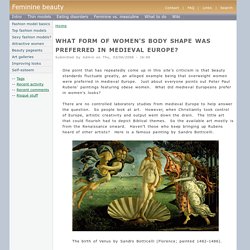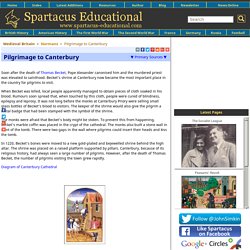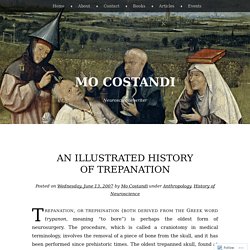

What form of women’s body shape was preferred in medieval Europe? One point that has repeatedly come up in this site’s criticism is that beauty standards fluctuate greatly, an alleged example being that overweight women were preferred in medieval Europe.

Just about everyone points out Peter Paul Rubens’ paintings featuring obese women. What did medieval Europeans prefer in women’s looks? There are no controlled laboratory studies from medieval Europe to help answer the question. So people look at art. However, when Christianity took control of Europe, artistic creativity and output went down the drain. Gap In Your Front Teeth? - Boldsky.com. In India alone there are more than a million people who have a gap between their two front teeth.

Though there are tons of people who do not like this gap, there are quite a number of them who are adoring this 'lucky gap'. If you have a gap between your two front teeth, it is considered to be lucky. But, then again there are some people who spend a lot of money on dental care trying to cover the gap. The gap between your teeth surely looks ugly if the gap is wide enough to pull your tongue through it! Here, Boldsky has mentioned some facts as to why we think you should keep the gap between your two front teeth. High, prominent forehead - What does your face reveal about you? The Canterbury Tales. English.

St. Thomas Becket - Archbishop, Saint. Pilgrimage to Canterbury. Soon after the death of Thomas Becket, Pope Alexander canonised him and the murdered priest was elevated to sainthood.

Becket's shrine at Canterbury now became the most important place in the country for pilgrims to visit. When Becket was killed, local people apparently managed to obtain pieces of cloth soaked in his blood. WHAT IS PILGRIMAGE? « RE:quest. Why would a Christian decide to go on a pilgrimage?

Are there any places in the world that you would love to visit? Take a moment to think about why. Perhaps you chose somewhere that is associated with someone special – for example, the town or country your grandparents were born, or where a hero of yours lives. Perhaps you chose a place you have heard a lot about and would love to see for yourself. Geoffrey Chaucer - Author, Poet. English poet Geoffrey Chaucer wrote the unfinished work, The Canterbury Tales.

It is considered one of the greatest poetic works in English. Synopsis Poet Geoffrey Chaucer was born circa 1340 in London, England. In 1357 he became a public servant to Countess Elizabeth of Ulster and continued in that capacity with the British court throughout his lifetime. The Canterbury Tales became his best known and most acclaimed work. Early Life Poet Geoffrey Chaucer was born circa 1340, most likely at his parents’ house on Thames Street in London, England.
Geoffrey Chaucer is believed to have attended the St. Geoffrey Chaucer Biography - life, death, wife, school, young, book, information, born, house, marriage. Born: c. 1345 London, England Died: October 1400 London, England English poet, author, and courtier Called the father of English poetry, Geoffrey Chaucer is ranked as one of the greatest poets of the late Middle Ages (C.

E. 476 c.–1500). He was admired for his philosophy as well as for his poetic talents. His best-known works are The Canterbury Tales and Troilus and Criseyde. Early years and marriage The exact date and place of Geoffrey Chaucer's birth are not known. An illustrated history of trepanation. Trepanation, or trephination (both derived from the Greek word trypanon, meaning “to bore”) is perhaps the oldest form of neurosurgery.

The procedure, which is called a craniotomy in medical terminology, involves the removal of a piece of bone from the skull, and it has been performed since prehistoric times. The oldest trepanned skull, found at a neolithic burial site of Ensisheim in France, is more than 7,000 years old, and trepanation was practised by the Ancient Egyptians, Chinese, Indians, Romans, Greeks and the early Mesoamerican civilizations. The procedure is still performed today, for both medical and non-medical reasons. The Hole Story on Trepanation. Hippocrates endorsed its use and it’s the world’s second oldest surgical procedure following circumcision.

It’s called trepanation and it literally means drilling a hole in your head. And if you think it’s a bygone practice, think again. The practice of making a hole in the skull has been around since the Stone Age — archaeologists have found trepanned skulls dating back to 3000 B.C. 10 Bizarre Medieval Medical Practices. Creepy Medicine is one of the cornerstones of modern civilization—so much so that we take it for granted.

It wasn’t always the case that you could just waltz into a doctor’s office to have them cure what ailed you. In medieval times, for example, things were a lot more dangerous, and a lot stranger. 10 Boar Bile Enemas Enemas in medieval times were performed by devices called clysters. Even kings were high up on the clyster. 9 Urine Was Used As An Antiseptic. Medieval Witchcraft. Facts and interesting information about Medieval Life,specifically, Medieval Witchcraft Medieval Witchcraft - White Witches, Wise Women and Cunning FolkDuring the early and middle Medieval era, up to the Renaissance period, the wisdom of the 'Wise women' or 'Cunning Folk' - the White Witches - were seen as helpful, if not invaluable, members of their communities. Their knowledge of the healing properties of various plants and herbs were often passed down through the generations. Their role was to provide help for people in need. Tony Robinson on the top five superstitions that gripped medieval Britain.
Ancient Britons didn’t despatch people willy-nilly, but in times of crisis – if a whole community was rocked by plague, say – then they might decide to sacrifice somebody as a way of bartering with the gods. In some cases, a wicker pyre in the shape of a man would be stuffed with animals and even human offerings. We can trace this practice back to Celtic times. The Middle Ages: Feudal Life.